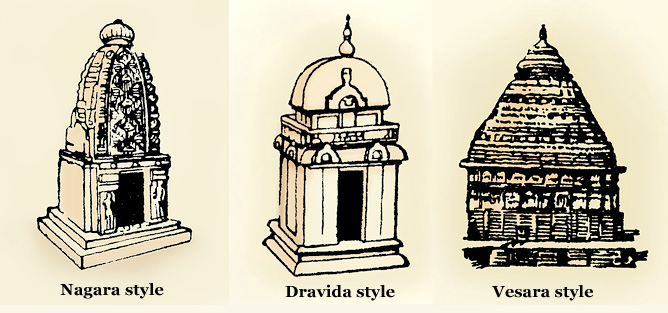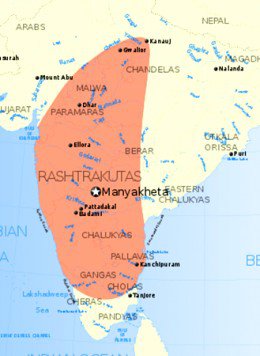-
Chapter 12: SOUTH INDIAN KINGDOMS
Pallavas dynasty:
After the Sangam age ended, the Kalabraha's captured the south and ruled for 250 years till the Pallavas dynasty started. The Pallavas ruled till they were ended by the Imperial Cholas in 10 century AD.
Their origin is widely disputed due to insufficient evidence. However they are believed to be natives of the area. Initially they were feudatories of the Satvahana but later declared independence.
The three lines of Pallavas rulers existed.
Initially they issued their charters in Prakrit and later on in
Sanskrit.
The third line ended the Kalabraha rule in south
and firmly established Pallavas dynasty till it was ended by
Imperial Cholas.
Features of the Pallavas Era:
The dynasty saw continuous Pallavas Chalukya conflict. The Chalukya would win over territory but lose it in next wars. The Pallavas also engaged in naval expeditions and sent embassies to china. Trade too flourished in the Pallavas era.Administration:
The hereditary monarchy was a feature. The king was assisted by council.
The kingdom was divided into kottams and kottams were administered by officials.
A well trained army was maintained.
At village level sabhas and samiti's maintained village administration.
Land tax was main source of revenue.
Society:
- The rigid caste system was seen. Brahmins and royals enjoyed high status.
- Bhakti movement was flourishing. Nayanmars and Alvar's preached hymns. Vaishnavism and Shaivism improved due to these.
- Pallavas also constructed temples and gave grants to them.
- Buddhism and Jainism declined in this period. But the Pallavas were tolerant to them.
Education and literature:
- Sanskrit and Tamil literature flourished.
- Kanchi the Pallavas capital was an ancient centre of learning.
- Nayanmars and Alvar have composed hymns in Tamil.
- Music, drama and dance also developed in this era.
Art and Architecture:
- Dravidian temple building architecture emerged during this period. The rock cut temples of Pallavas were exemplary.
- Temple
architecture developed in four stages:
· Rock cut temples
· Rock cut monolithic Ratha's [monolithic shrine] and Mandapas [open pavilion, simple columned halls].
· Structural temples E.g. Kailashnatha temple is the greatest specimen of Pallavas architecture.
·
Structural temples in Rajsimhan style
3. Open art gallery too were started during this period.
Western Chalukya dynasty:
The Western Chalukya was an important power in the
Deccan ruling an extensive Empire. Pulekasin I was the founder
and his capital was at Badami. The eastern Chalukya were at
Vengi and Chalukya of Kalyanis were offshoots of Western
Chalukya.
Pulekasin II was the most important ruler. He defeated Harsha and checked his ambition to rule the Deccan. He also led a successful expedition against the Pallavas. He was later defeated and the Vatapi capital was plundered by the Pallavas. The last king of Chalukya was defeated by Dandidurga, Founder of Rashtrakutas.
Administration and Social Life:
- The centralized administration under the king was a unique feature of Chalukya. Village autonomy was absent.
- Brahmanism was the main religion and the Chalukya kings performed rituals and sacrifices.
- Buddhism declined but Jainism progressed in this dynasty.
Art and architecture:
- Vesara style of structural temples was developed in the Chalukya dynasty.
- Telegu literature developed.
- The Aihole inscription was composed. Aihole is the cradle of indian temple architecture.s
- Chalukya cave temple architecture and paintings were seen at Ajanta, Ellora and Badami.
- Temple building
developed in two stages:
Stage 1: Temples had low flat roof with pillared
halls. The walls and pillars are adorned with images of gods and
humans.
Stage 2: Dravidian influence is seen. Partly the northern style is continued.

Fig 1: Vesara style
Rashtrakutas dynasty:
Dandidurga was the founder of the Rashtrakutas dynasty. Initially were feudatories of Chalukya. He defeated Gurjaras and annexed Malwa, he also annexed the Chalukya kingdom. Thus Rashtrakuta became the paramount power in Deccan. The Rashrakuta kings went to the south to Rameshwaram. They built temples in conquered lands.

Fig 2: Rashtrakuta empire
Administration:
Empire was divided into several rashtras. The rashtras into vishayas and further into bhuktis.
The village assemblies played important role. Thus administration wasn’t centralized as chalukyas.
Society and Economy:
1. The Brahminism sects like Shaivism and Vaishnavism prospered.
2. The progress of Jainism continued but Buddhism declined. But harmony was existing between different religions.
3. Trade between arabs and Deccan flourished.
Cultural contributions:
1. Sanskrit literature flourished due to the patronage from the kings.
2. Kannada literature too started emerging
3. Jain literature too came forward and many poets and writers emerged.
Art and Architecture:
1. Art and architecture of Rashtrakutas was found at Ellora and Elephanta.
2. The Kailas temple at Ellora is an architectural marvel. It has a main shrine, entrance gateway, mandap and a subordinate shrine for nandi. The shikhar of the temple is three tiered. The beautiful sculptures and pillared halls make it visually appealing.
Solved Question Papers
Q.Consider the following pairs :
Place of Pilgrimage: Location
1. Srisailam : Nallamala Hills
2. Omkareshwar : Satmala Hills
3. Pushkar : Mahadeo Hills
Which of the above pairs is/are correctly matched? (UPSC CSAT 2015)
1 only
2 and 3 only
1 and 3 only
1, 2 and 3
Ans . A
The town (as well as the mandal) of Srisailam is reputed for the shrine of Lord Mallikarjuna on the flat top of Nallamala Hills.
Omkareshwar is situated on the Mandhata hills in Madhya Pradesh, known in ancient times as Shivpuri. The temple dates back to the Krita Yuga. River Narmada flows here around the Mandhata hill in the form of an Om (Omkaram).
The Mahadeo Hills are a range of hills in Madhya Pradesh state of central India. But, Pushkar lies in Ajmer, Rajasthan.
Q.Who of the following founded a new city on the south bank of a tributary to river Krishna and undertook to rule his new kingdom as the agent of a deity to whom all the land south of the river Krishna was supposed to belong? (UPSC CSAT 2015)
Amoghavarsha I
Ballala II
Harihara I
Prataparudra II
Ans . C
He was the founder of Vijayanagar Empire.
His initial military exploits established his control over the valley of Tungabhadra River (a tributary of Krishna), and gradually he expanded his control to certain regions of Konkan and Malabar Coast.
By that time Hoysalas had lost its last ruler Veera Ballala III who died fighting the Sultan of Madurai, and the vacuum so created facilitated Harihara I to emerge as a sovereign power. The entire Hoysala territories came under his rule directly